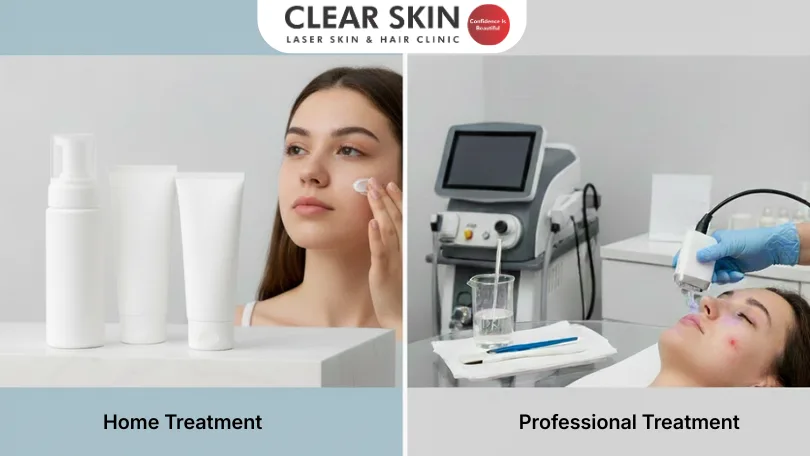- Home /
- Blogs
Skin Central: Your Source For Clear Skin Knowledge
Your Ultimate Destination for Expert Insights on Achieving Clear and Healthy Skin.

How to Build an Acne Treatment Routine for Your Skin Type in Pune?
Which acne treatments work best for your skin type in Pune? Compare professional vs at-home options with costs, effectiveness & timelines. Expert guide from Dr. Dhanraj Chavan.
How to Get Rid of a Blind Pimple Safely and Effectively?
Painful blind pimples that don’t heal? Get expert acne treatment at Clear Skin Clinic Pune by a senior dermatologist.
Skincare Routine for Oily and Acne-Prone Skin
Simple, dermatologist-recommended skincare routine to control oil, prevent acne, and maintain healthy skin with long-term results.
How to Build an Acne Treatment Routine for Your Skin Type in Pune?
Clear Skin Clinic Pune reviews: 4.9/5 stars across 13,271+ verified reviews. Real patient experiences, treatment timelines & acne success stories.
Does Kajal Cause Dark Circles Demo
Not all dark circles come from kajal. Know the real causes, dermatologist advice, and proper makeup removal methods to protect your eyes.
HydraFacial Treatment in Pune | Cost, Benefits, Process & Results
Get instant glow with HydraFacial in Pune. Safe for sensitive skin, no downtime, visible results. Book dermatologist-supervised HydraFacial at ClearSkin.
Non-Surgical HIFU Treatment in Pune | Skin Tightening
Looking for HIFU treatment in Pune? Get safe, dermatologist-led skin lifting for face, jawline, and neck with no downtime.
Most Comprehensive Patient Guides

Difference Between Acne And Pimples

Do Acne Scar Removal Creams Really Work?

How to Reduce Lip Pigmentation: Effective Methods

Powerful Home Remedies for Dark Circles
Dermatologist Insight: Decoding Popular Claims
Grab Your Free E-Book
We are committed not only to treating you, but also educating you.
Most Read Blogs
IV Drip Therapy in Pune: Prices, Types & Value
Home / Blogs/Cost of IV therapy in PuneIV drip Therapy Price for Skin glowIf you’re considering IV drip therapy in Pune, understanding the price range and what influences the cost can help you make a confident and informed decision.Vitamin IV drip therapy is quickly...
Pune Acne Treatment Reviews – What Real Patients Say About Clear Skin Clinic?
Home / Blogs / Pune Acne Treatment Reviews – What Real Patients Say About Clear Skin Clinic? Acne Treatment Reviews – What Real Patients Say About Clear Skin Clinic?Searching for honest reviews about acne treatment in Pune? Clear Skin Clinic holds a 4.9 out of 5-star...
The Top Benefits of IV Drip Therapy
Home / Blogs / The Top Benefits of IV Drip TherapyThe Top Benefits of IV Drip TherapyIV drip therapy is a simple and effective way to recharge your body, restore essential nutrients, and support overall health from the inside out.IV drip therapy is a treatment that...
IV Drip Therapy in Pune & PCMC: How It Works
Home / Blogs / IV Drip Therapy: What Is It and How Does It Work?IV Drip Therapy: What Is It and How Does It Work?Modern lifestyles can leave the body drained—IV drip therapy helps restore balance, hydration, and vitality from within.Have you ever felt completely...
Can You Get Acne on Dry Skin? Causes and Medical Treatments
Home / Blogs / Ultimate Skincare Solutions – Dry Skin AcneCan You Get Acne on Dry Skin? Causes, Care, and Medical TreatmentsDiscover how to combat dry skin acne & achieve radiant skin. Expert skincare tips to hydrate & prevent breakouts. Having acne is...
Why Acne Comes Back After Stopping Treatment? – Pune Insights
Home / Blogs /Why Acne Comes Back After Stopping Treatment? – Pune InsightsWhy Acne Comes Back After Stopping Treatment? – Pune InsightsYou finally cleared your acne after months of treatment. Your skin looked great, you felt confident, and everything seemed perfect....
Pune Acne Treatment Costs – What to Expect in 2026?
Home / Blogs / Pune Acne Treatment Costs – What to Expect in 2026?Pune Acne Treatment Costs – What to Expect in 2026?Acne treatment in Pune involves professional dermatological interventions from topical medications to laser therapy. Professional treatment becomes...
Laser vs Microneedling – Best Acne Scar Treatment in Pune?
Home / Blogs / Laser vs Microneedling – Best Acne Scar Treatment in Pune?Laser vs Microneedling – Best Acne Scar Treatment in Pune?Acne scars result from inflammatory acne lesions that damage the skin's collagen structure during healing. Two primary treatment options...
How Long Do Acne Treatments Take to Show Results in Pune?
Home / Blogs / How Long Do Acne Treatments Take to Show Results in Pune?How Long Do Acne Treatments Take to Show Results in Pune?Acne treatment timelines in Pune range from 4 weeks to 6 months depending on treatment type and acne severity. Most patients see initial...
Can You Do Laser Hair Removal Over Tattoos?
Home / Blogs / Can You Do Laser Hair Removal Over Tattoos?Can You Do Laser Hair Removal Over Tattoos?Looking for a way to get rid of pesky hair but concerned about the impact of laser hair removal on your tattoos? Can you do laser hair removal over tattoos? Let’s...
Does Melasma Go Away in Winter?
Home / Blogs / Does Melasma Go Away in Winter?Does Melasma Go Away in Winter?In this article, we will explore the relationship between melasma and winter and shed light on whether or not the colder season can relieve persistent dark spots.Melasma is often exacerbated...
Cost of Acne Scar Treatments in Pune – What Patients Should Know?
Home / Blogs / Cost of Acne Scar Treatments in Pune – What Patients Should Know?Cost of Acne Scar Treatments in Pune – What Patients Should Know? Acne scar treatment costs in Pune typically range from ₹2,000 to ₹25,000 per session depending on the treatment type and...
Didn’t Find What You Were Looking?Please
Contact Us.
We are committed not only to treating you, but also educating you.
